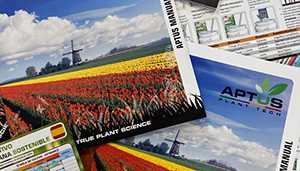What EC Should I Use?
One of the most common questions new Aptus users have is: What EC value should I keep in my nutrient solution? Unfortunately, there’s no easy answer here, as it’s dependent on a lot of variables like crop, climate, and growth phase, but we’ll attempt to clear some of the fog surrounding EC in this article!
WHAT IS EC EXACTLY?
EC stands for electrical conductivity, and it’s used to measure the dissolved salts in a solution. This conductivity is determined by the amount and the nature of dissolved ions (such as potassium, calcium, nitrate, etc.) in the solution. Clean water has an EC of 0,0.
The EC of your nutrient solution is of great importance, especially when you’re growing on substrates. For example, if your tap water already has an EC 3,0 there’s no possibility of adding more nutrients without the EC reaching heights that result in stunted growth or lowered yield. Even if the water is at the EC level you want, you have no idea what exact nutrient ions are in there, as EC says nothing about specific nutrient ratio’s in your solution.
For your plant’s roots, it’s easiest to take up nutrients out of a solution with a low concentration of nutrients, or rather a solution with a low EC compared to its internal EC. In that case, the concentration of ions in the root cell is bigger than the concentration outside, and that brings about an osmotic pressure: The water is pulled into the cell.
It gets harder when the root zone itself already has a fairly high concentration of ions compared to the plant’s internal EC. The plant then has to make internal adjustments to be able to take up nutrients from the soil solution.
THE OPTIMAL EC
There’s a conflict between uptake of water and uptake of nutrients in a plant. For optimal water uptake, plants need a low EC. However, a low EC means only a few nutrients in the solution. Too few nutrients and you risk nutrient deficiencies.
As growers, we are always looking for the sweet spot between little water stress and sufficient nutrients.
Generally, low EC results in lush growth as long as the plant still getting enough nutrients. Growers sometimes choose to intentionally increase EC to higher than optimal growth levels. This can be done to stimulate generative growth (fruit & flower production) or to increase flavor (which does cost some yield and doesn’t work on all crops).
As the EC increases, growth and yield become more and more limited. That has three causes.
First of all leaf development is curbed. Because the plant can take up less water the new cells that need to stretch can’t reach enough cell pressure. That leads to shorter cells and smaller leaves, which results in less light caught by the leaves, which in turn results in less photosynthesis and growth, so lower yield.
The second effect of an EC that is too high, is that the plant closes its stomata. Plants do that to limit the evaporation when they can’t take up enough water. But, because of that, less CO2 can enter the leaves, which is necessary for proper photosynthesis. The less efficient photosynthesis in turn results in a decreased yield (if this continues for a prolonged period).
Both these reactions cost yield, and therefore money.
The third (and final) effect of high EC has a positive side to it too. Even though the increase in EC results in a lower yield, it can improve the flavor! This is done by increasing EC to the point where it’s not yet affecting the dry-weight of the fruit (as photosynthesis is not yet hindered), but where there’s already less water going to the fruit. One could say the fruit is being less ‘diluted’ with water. A higher dry-weight in fruiting vegetables means a higher Brix (sugar level) which results in better flavor.
This trick has been used to improve the flavor of tomatoes, and lots of producer organizations are now setting minimum requirements for EC because of it. However, this can’t be used for all fruiting vegetables, as some already have a very high dry-weight. An increase in EC could potentially still improve flavor, but it will be significantly less than fruiting vegetables with a relatively low dry-weight.
SO WHAT EC SHOULD I USE?
As we’ve mentioned at the beginning of this article, this is a hard question to answer. What we recommend is to start out with a low EC and start building it up as the plant grows. This way you slowly increase the plant’s internal EC because as the water evaporates the nutrients stay behind in the plant. The higher internal EC allows you to feed your plants a higher EC the next watering again, and this cycle can be repeated to push your plant further.
But, be careful and make sure you keep a good eye on your plants! As soon as you notice any stunted growth or discoloration of the leaves, you probably gave them too much.
Also, keep in mind that your plant uses relatively more water when temperatures are high, so you may want to keep your EC a bit lower in summer than you do in winter.
Still have some questions after reading this? Don’t hesitate to contact us!





